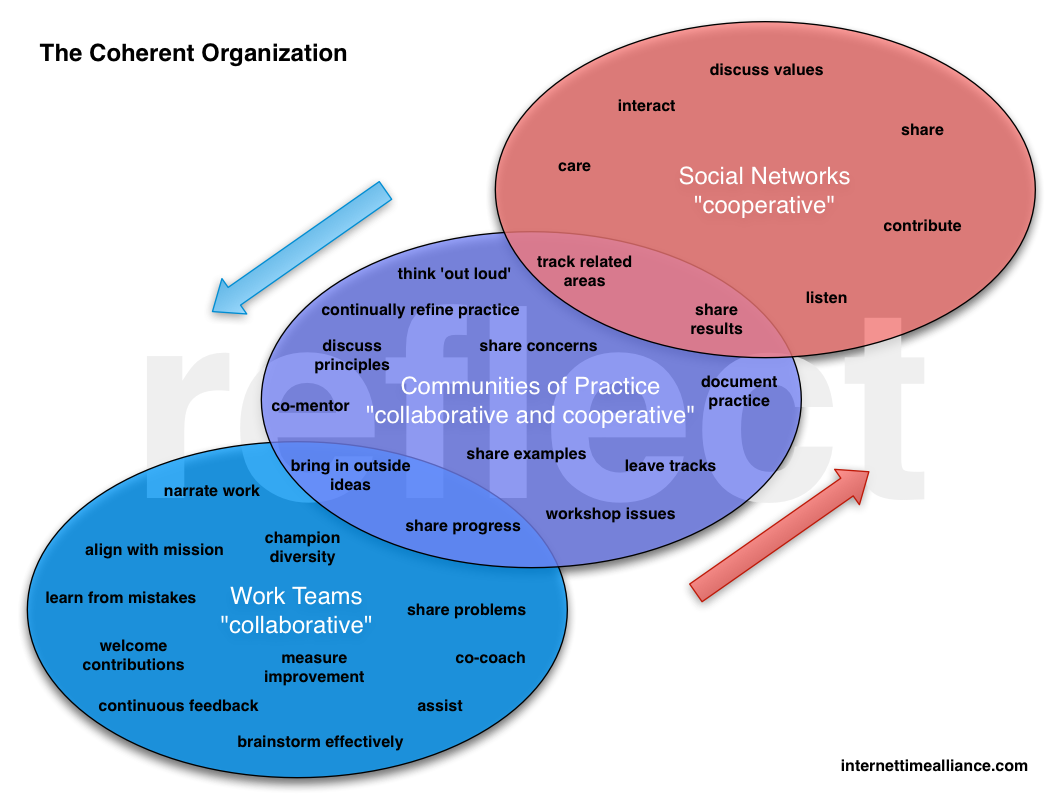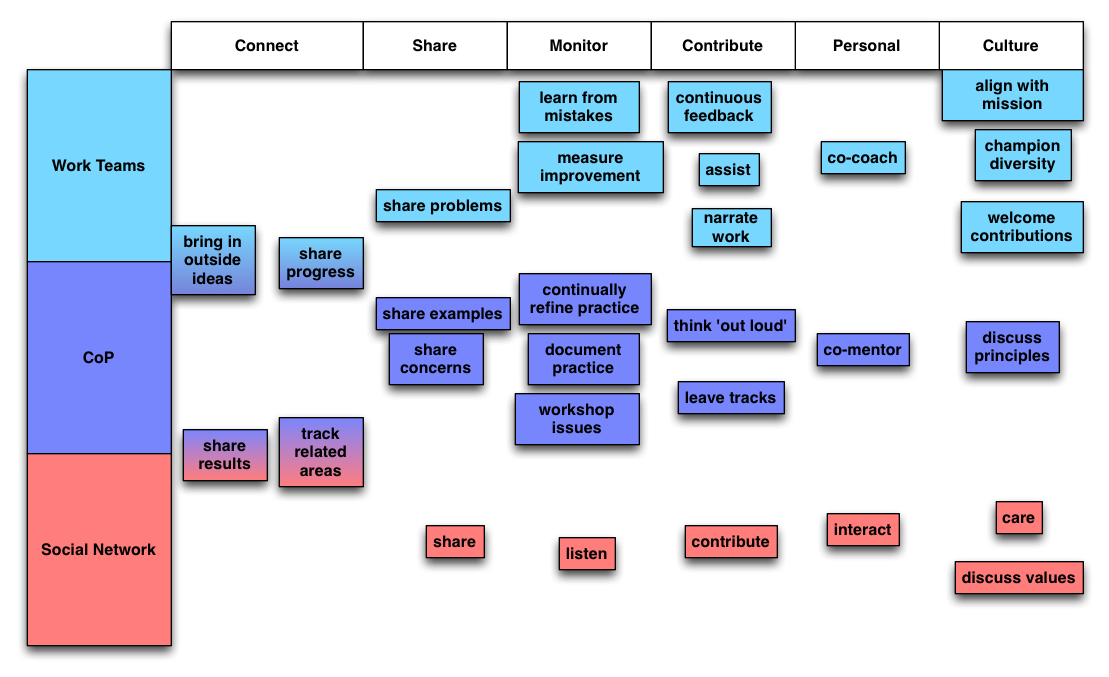As excited as I am about the Coherent Organization as a framework, it’s not done by any means. I riffed on it for a Chief Learning Officer magazine, and my Internet Time Alliance colleagues have followed up. However, I want to take it further. The original elements I put into the diagram were ad-hoc, though there were principles behind them. As a start, I wanted to go back and look at these elements and see if I could be more systematic about it.
 I had, as Harold’s original model provided the basis for, separate groups for Work Teams, Communities of Practice, and Social Networks. Within each were separate elements.
I had, as Harold’s original model provided the basis for, separate groups for Work Teams, Communities of Practice, and Social Networks. Within each were separate elements.
In Work Teams, I had included: share problems, co-coach, assist, brainstorm effectively, continuous feedback, welcome contributions, learn from mistakes, align with mission, narrate work, champion diversity, and measure improvement.
Under Communities of Practice I listed: document practice, leave tracks, workshop issues, share examples, co-mentor, discuss principles, continually refine practice, think ‘out loud’, and share concerns.
And in Social Networks I had put: share, contribute, listen, care, interact, and discuss values. I also had connecters between the groups, each ways, so Work Teams were connected to Communities of Practice by bringing in outside ideas and sharing progress, while Communities of Practice were linked to Social Networks by tracking related areas and sharing results.
What I couldn’t claim was that this was the exhaustive list. I’d put them in there with some thoughts of both putting in and taking out, but I wanted to go further.
What I did was separate out each of the three areas, and start grouping like terms together (I just took all the terms in the above diagram and dropped them into a new diagram, and started sorting). As I did so, some commonalities emerged. I ended up with the following diagram, which is very much a work in progress. What I’m trying to get to is the set of behaviors that would be essential for such an organization to succeed, ultimately coming up with a set of dimensions that might be useful as an assessment. What emerged is a characterization of several different areas within which behaviors fall, which is useful because then I can look for missing (or redundant) elements.
 In addition to the connecting tasks, we see several overarching types of behaviors. Besides the connection between the areas, they grouped like I show here.
In addition to the connecting tasks, we see several overarching types of behaviors. Besides the connection between the areas, they grouped like I show here.
Sharing is individual putting out things, which is less pro-active and interactive than actually contributing. That distinction isn’t quite clear to me either, but sharing might be more pointers to things where contribute is a more substantial contribution. Which means my elements may not be properly categorized.
Monitoring is both watching what’s going on and pro-actively evaluating outcomes. Does this need to be broken out into two separate areas? Personal is where you’re working with a specific person (or recipient thereof). And the culture dimension is where you’re actively aware of and reviewing the underlying values behind what you’re doing.
By no means do I consider this ‘done’, but I share it as part of my commitment to practicing what I preach, thinking ‘out loud’. This will get refined. I most certainly welcome your thoughts!
#itashare
Clark – I’ve been following Harold’s writing on this and I’m going to spend some time now absorbing and thinking about your matrix. There is alot in there and I look forward to further refinements but I would say that you have already produced something that is incredibly valuable. Thank you.
I sincerely appreciate how you’re modeling the out-loud thinking on this, Clark.
The more I look at the circles and the matrix, the more I wonder if the distinction between work teams, CoPs and social networks is necessary.
Would it be fair to say that each individual, whether working independently or in a coherent team/CoP/network, is responsible for connecting, sharing, monitoring, contributing, interacting and shaping culture?
I keep re-reading the attributes and feeling like each group should be modelling them all, particularly bringing in outside ideas, refining practice, thinking out loud, welcoming contributions. If every individual formed these new habits, the culture would shift dramatically, no?
P.S. I’d like to suggest a couple of dimensions for this framework:
– fostering trust (see work of Stephen M. R. Covey)
– taking risks
Рfeeling safe to fail (also known as sharing vulnerability Рsee the work of Bren̩ Brown)
Ara, glad if it helps.
Adam, thanks for the feedback. I think it’s valuable to think about the 3 groups separately, because I think while the individual has to be active in each, there’s a different flavor (as Harold identified in separating out cooperation from collaboration), though there’s overlap. And I don’t have the cultural elements that need to backstop making this work, but I like this model: http://blog.learnlets.com/?p=612. Experimentation is taking risks, psychological safety is there. Trust is an important issue, wondering if those other elements *lead* to trust, or there needs to be more.